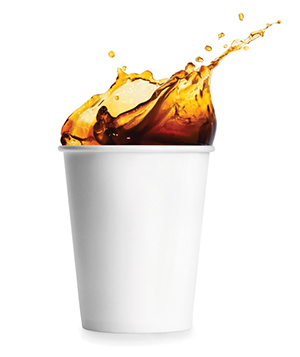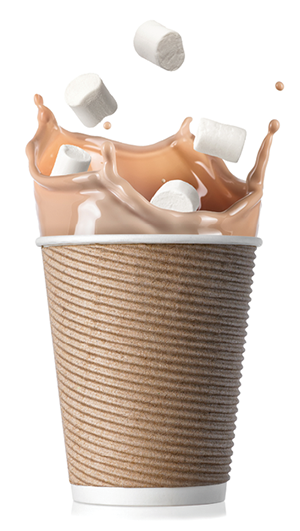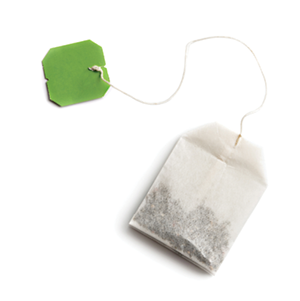After two years of working from home, Marty Ruiz returned to her office on a part-time basis. On the three days she commutes, she stops at a convenience store for a rich, hot latte. Other mornings she brews java in her kitchen, adding oat milk and sweetener.
“Coffee in the morning is non-negotiable,” she said. “When I drive to the office, stopping for a cup that I can customize myself is part of my ritual. But when I work at home, I never go out that early. So, I make it myself. It’s cheaper.”
You don’t make money buying cheap coffee; you make money selling great coffee.”
For decades, most convenience store hot dispensed beverage sales occurred between 6 and 8 a.m. on weekdays. But during the pandemic, one-third of morning commuters were working at home, according to the U.S. Census Bureau. Although more employees are back in the workplace, morning hot dispensed beverage sales have not returned to pre-pandemic levels (2019) but were slightly higher in 2021 compared to 2020.
"According to the U.S. Census Bureau, in 2021, about 68% of workers drove alone to work, compared to roughly 76% in 2019,” said Jayme Gough, research manager at NACS. “That corresponds to nearly 15 million fewer people commuting.”
 Convenience store coffee sales rebounded in 2021, but relative to other dispensed beverage subcategories, coffee did not recover to the same degree. The NACS State of the Industry Report® of 2021 Data indicates that although coffee sales improved by 6.9% year over year to $3,976 per store, per month, this modest increase did not prevent coffee from declining from 82.6% of hot dispensed beverage sales in 2020 to 79.1% in 2021.
Convenience store coffee sales rebounded in 2021, but relative to other dispensed beverage subcategories, coffee did not recover to the same degree. The NACS State of the Industry Report® of 2021 Data indicates that although coffee sales improved by 6.9% year over year to $3,976 per store, per month, this modest increase did not prevent coffee from declining from 82.6% of hot dispensed beverage sales in 2020 to 79.1% in 2021.
 Coffee gross profit also rose slightly, improving by 5.2% to $2,672 per store, per month. Coffee gross margin was impacted by rising costs, however, resulting in a decline of 1.10 percentage points to 67.20%.
Coffee gross profit also rose slightly, improving by 5.2% to $2,672 per store, per month. Coffee gross margin was impacted by rising costs, however, resulting in a decline of 1.10 percentage points to 67.20%.
“Position beverages as affordable treats that offer consumers a reprieve from stressful times.”
Sweet sales came from hot chocolate, which rose from 6.9% of hot dispensed beverage sales to 9.0% in 2021. Hot chocolate gross profit also expanded, rising to $289 per store, per month in 2021, an improvement of 35.7%, according to the NACS State of the Industry Report.
Among consumers purchasing hot dispensed beverages, nearly 90% chose coffee and specialty coffee. “From 2020 to 2021, specialty coffee’s share of the category increased from 6.5% to 9.7%,” said Gough.
“Equipment innovation, such as bean-to-cup machines, permits greater consumer customization and lets retailers better meet the needs of shoppers looking for something like a cappuccino or latte. Generation Z loves to customize their beverages as much as possible,” she said.
 REACHING GEN Z
REACHING GEN Z
When it comes to the beverage bar, millennials and Gen Z love variety and embrace new flavors and innovations.
“For 2023, expect to see more operators introducing global-inspired flavors to their menu, particularly Southeast Asian flavors,” said Chairil McClain, senior director of market insights and portfolio strategy at BUNN.
McClain said that one flavor gaining a lot of attention is Salted Egg Yolk, a rich custardy flavor that consists of umami (savory) notes.
“And don’t be surprised to find chunks of fruit in your cold coffee. Cold fruit lattes are popping up at some U.S. coffee shops. Banana, avocado and mango are typical ingredients added to an iced espresso that is mixed with thick fruit puree and milk. As with bubble tea, a thick straw is the best way to consume it,” McClain said.
According to Mintel’s Foodservice Coffee & Tea-U.S. report for 2022, 65% of Gen Z consumers have ordered a cold coffee drink away from home in the past three months, compared with 33% who have ordered a hot coffee drink.
Today, cold drinks make up 75% of Starbucks’ beverage sales. In 2022, Howard Schultz, then-CEO of Starbucks, told analysts that Gen Z customers choose cold drinks and customize their beverages with sweeteners, toppings, flavored sugars and syrups to create concoctions that they share on social media.
 “[Gen Z] also over-index on using plant-based milks and creamers,” said Donna Hood Crecca, principal at Technomic. “Courting younger consumers will require retailers to invest in a robust condiment offering on the hot beverage station.”
“[Gen Z] also over-index on using plant-based milks and creamers,” said Donna Hood Crecca, principal at Technomic. “Courting younger consumers will require retailers to invest in a robust condiment offering on the hot beverage station.”
“For 2023, expect to see more operators introducing global-inspired flavors to their menu, particularly Southeast Asian flavors.”
Crecca noted that half of consumers overall would like to see more customization options for hot beverages at convenience stores.
“Because cold coffee drinks can cannibalize hot coffee offerings, retailers should strategically market cold offerings to satisfy specific need states, like refreshment, and hot coffee to satisfy the energizing/pick-me-up need state. This positions the store as able to satisfy all their coffee needs,” she said.
BRING IN BEVERAGE FANS
The first step to building a successful hot beverage program is focusing on the basics.
“Beyond price, consumers prioritize speed of service, flavor, freshness and quality,” said Crecca. “C-stores overall tend to win on speed but fall short of other segments. Once the basics are nailed down, retailers should present relevant and differentiating limited-time offers to keep the program fresh and interesting and invest in condiment and creamer options.”
 Don’t shy away from trends, said Brittany Tresemer, marketing director at Franke Coffee Systems.
Don’t shy away from trends, said Brittany Tresemer, marketing director at Franke Coffee Systems.
“Operators must continue to develop unique innovative beverages that consumers can’t make for themselves,” she said. Research shows that “57% of consumers believe purchasing coffee from a foodservice location is only a value when they get drinks they can’t make in their own homes. C-store chains must also rely on valuable discounts, promotions and sampling programs to draw
in value-conscious consumers. Position beverages as affordable treats that offer consumers a reprieve from stressful times,” Tresemer said.

“There is an old saying in the coffee industry,” said Frank McAdam, sales vice president at BUNN. “You don’t make money buying cheap coffee; you make money selling great coffee.
For 2023, expect to see more operators introducing global-inspired flavors to their menu, particularly Southeast Asian flavors.”
Since the pandemic, the convenience retail industry has sought ways to improve the customer experience “by providing more selections, adding automation to help with simple tasks and consistency and focusing on value,” said McAdam.
Jack Kimberly, national account executive for Royal Cup Coffee, advises that consistency is key. Retailers who focus on a selection of hot and cold coffee beverages, limited-time offers that appeal to their location’s demographics and a variety of customization options “will be competitive for a share of the cup.”
Tea for Two
 According to the Tea Association of the USA, approximately 75% to 80% of tea consumed in America is iced. Arthur Lopez, senior director of marketing for Finlays, sees much untapped opportunity for tea in convenience stores.
According to the Tea Association of the USA, approximately 75% to 80% of tea consumed in America is iced. Arthur Lopez, senior director of marketing for Finlays, sees much untapped opportunity for tea in convenience stores.
“Look at tea globally. You have traditional chai tea beverages, matcha lattes and London Fog, which is traditional Earl Grey with other ingredients added,” he said.
“There’s a strong emphasis on lattes in the U.S, and there are good latte tea products available that Americans don’t even know about. There’s an opportunity to make these products available to consumers so they can educate themselves about tea. But it will take some time.”
The Power of CSX Data

CSX, the engine behind category metrics and NACS State of the Industry data, provides current and customizable tools for financial and operational reporting and analysis in the convenience industry. Retailers can measure their company by any of the myriad metrics generated via our live database. Contact Chris Rapanick at (703) 518–4253 or crapanick@convenience.org for a complimentary executive walkthough.